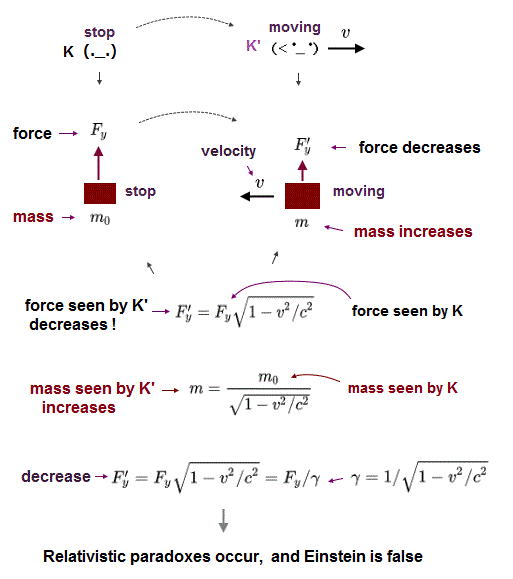
(Fig.1) Force Fy acting on a stationary mass (= m0 ) seen by a stationary K observer appears to decrease to F'y seen by a moving observer K'.

In the upper figure, a stationary object with rest mass m0 is pulled by force Fy as seen by a stationary observer K.
According to Einstein relativistic theory, as seen by an observer K' moving rightward at a velocity of v, this object appears to move leftward, and the force Fy (= or F⊥ ) acting on this object magically appears to decrease to Fy' = Fy/γ where γ is Lorentz factor γ = 1/square root of 1-v2/c2, which means "moving force Fy'" decreases or weakens ( this p.15, this-last, this p.35, this p.5-(44), this p.25, p.45-(7.14) ).
This unphysical force change seen by differently-moving observers K and K' is necessary to satisfy the ad-hoc relativistic mass, energy and momentum p relation where force F is equal to the time derivative of relativistic momentum p (= F = dp/dt ).
On the other hand, the mass m0 seen by a stationary K appears to increase to m = γm0 called relativistic mass as seen by K' according to Einstein relativistic theory.
This unphysical force change Fy → F'y seen by different observers causes serious irreparable paradoxes showing Einstein relativity and relativistic mass energy are false.
(Fig.1') Electric force Fy acting on stationary plates with positive and negative charges attracting each other seen by a stationary observer K also appears to decrease to Fy' as seen by a moving observer K' in relativity.
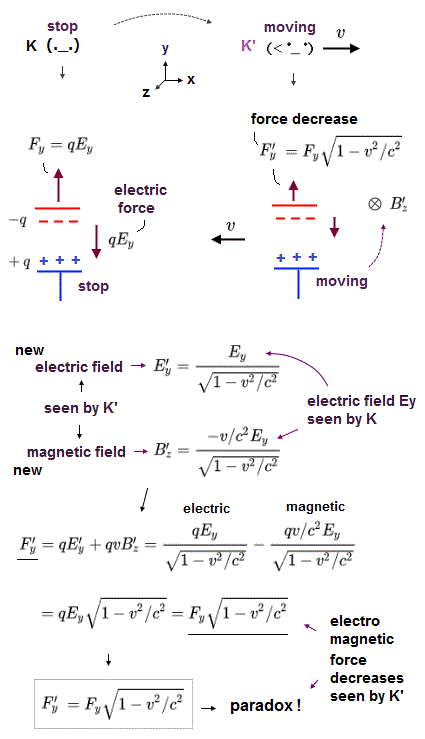
Einstein relativistic theory demands that force Fy changes as seen by differently-moving observers K and K' to satisfy relativistic energy, mass and momentum relation.
Also in (paradoxical) relativistic electromagnetism, we can know that the electromagnetic force changes depending on different observers in the same way as Fig.1 ( this p.35-36 )
In the upper figure, two stationary plates which are positively and negatively charged (= ±q ) are attracting each other by the electric force qEy as seen by the stationary observer K.
When seen by the K' moving at a velocity v in x direction, these two plates appear to be moving in -x direction at v, which motion causes fictitious magnetic repulsion between these two plates, and decreases the force Fy to Fy' = Fy/γ in the same way as Fig.1
The electric attraction (= qEy' ) seen by K' increases ( Ey' = γEy > Ey, this p.14 ), but new magnetic repulsion (= qvBz' = Lorentz magnetic force where Bz' = -γv/c2Ey, this p.10 ) is stronger and eventually decreasing the total force (= electromagnetic attraction between two charged plates ) from Fy to Fy' according to Einstein relativity.
(Fig.2) A stationary rectangular rail pulled by two equal forces (= upper force Fy is at rest, lower force Fy is moving in x direction ) seen by a stationary K appears to move downward seen by a moving K', which is paradox !
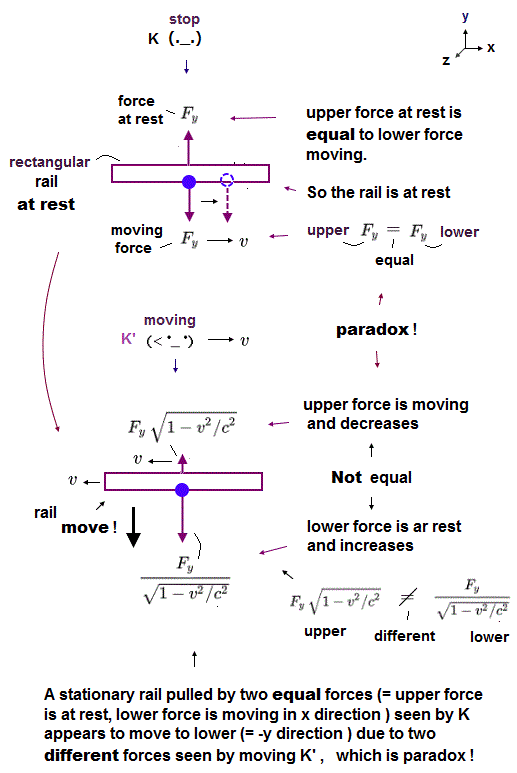
In the upper figure, a stationary rectangular rail is pulled by the upper force Fy at rest and the opposite equal lower force Fy moving in x direction as seen by a stationary observer K. ← upper force Fy = lower force Fy, so the rail remains at rest by these two balanced opposite forces seen by K
But as seen by another observer K' moving in x direction, the upper force Fy appears to be moving in -x direction and decrease (= Fy/γ ) due to relativistic force transformation.
And as seen by the K' observer moving in x direction, the lower force Fy appears to be at rest, hence increase to γFy from Fy seen by the stationary K.
As a result, the original stationary rail (= due to two balanced equal upper and lower forces ) seen by the stationary K appears to move downward (= due to two unbalanced unequal upper and down forces ) seen by the moving observer K'.
This is clearly paradox, and Einstein relativistic theory is false.
Right angle lever (= Trouton-Noble ) paradox is also one of fatal unsolvable relativistic paradoxes based on this unphysical force transformation.
(Fig.3) Einstein relativistic energy (= E ) and momentum (= p ) contain only "definite constant values" about a photon (= light ) such as a photon's zero constant rest mass (= m0 = 0 ) and a photon's velocity (= v ) equal to the constant light speed = c, which cannot explain an actual energy E = hf (= f is the variable of light frequency, Not the constant ) of photon (or light).
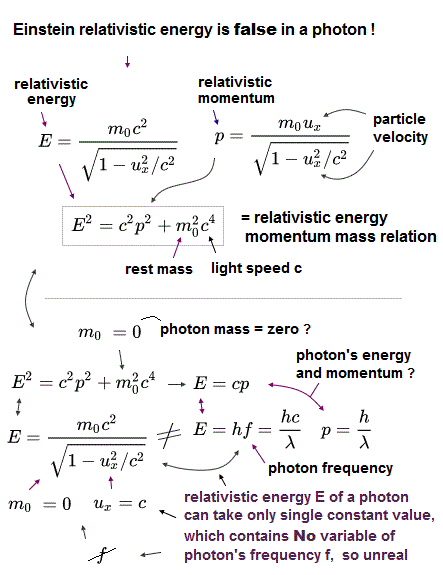
In fact, Einstein relativistic energy (= E ), relativistic momentum (= p ) cannot explain a photon's energy and momentum, so false.
It is said that the relation of a photon's energy (= E ) and momentum (= p = E/c where c is light speed ) can be obtained by substituting a photon's zero mass (= m0 = 0 ) into the relativistic energy-mass-momentum relation. But this is untrue.
↑ First of all, if a photon (or light ) with some ( relativistic ) energy has No mass (← really ? ) as stated by Einstein relativity, the photon disagrees with the definition of the relativistic mass (= m ) equal to the relativisic energy (= E ) divided by the square of the light speed c (= relation of m = E/c2 is violated only in a photon ! ), which is clearly self-contradiction (= Einstein relativity paradoxically claims the rest mass of a photon is zero, but the relativistic mass of a photon may not be zero ).
Furthermore, Einstein relativistic energy or momentum relations do Not include the variable or information about a photon's frequency (= f ) or wavelength (= λ ).
Relavistic energy (= E ) and momentum (= P ) relation contains only the definite constant values such as a photon's zero mass (= m0 = 0 = constant ) and the constant light speed v = c, which does Not contain any variables such as frequency f or wavelength λ (= light frequency or wavelength can take many different values, so Not constants ).
This means Einstein relativistic energy-momentum relation can express only one photon or light of only one constant energy, because it does Not contain variables or information expressing different light frequencies or different light wavelength.
So it is impossible for Einstein relativistic energy-momentum relation to describe actual lights (or photons ) with infinite kinds of different energies or momentums.
To be precise, the photon's energy E is proportional to photon's rest mass zero divided by zero (= light speed - light speed ), which photon's energy E = 0/0 is indeterminate and unable to designate some physical light (or photon ) energy based on light frequency. So Einstein relativistic energy cannot define photon energy.
(Fig.4) A stationary observer K sees an object A moving at a velocity of ux in x direction, which is observed to stop seen by the K' who is moving at the same velocity v = ux as the object A in x direction.
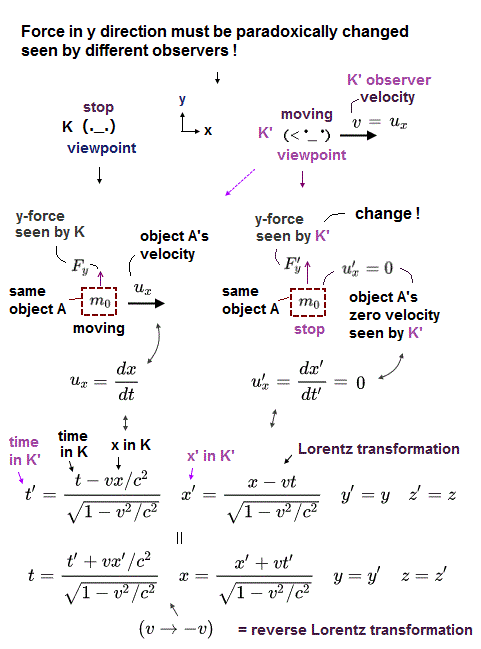
Here, we actually calculate the relativistic Lorentz tranformation of an object's velocity (= ux = velocity in x direction seen by K, u'x = velocity in x direction seen by K' ) and forces (= Fy is the force acting on the object A in y direction seen by K, F'y is the force acting on the object in y direction seen by the moving K' ).
A object is supposed to be moving in x direction at a velocity of ux seen by a stationary K observer, and this same object A appears to stop seen by another observer K' moving in x direction at the same constant velocity v = ux (= temporarily ) as the object A at this point. (= K's velocity v is the constant, but a object's velocity ux is Not constant, because of being accelerated by force in x direction ).
(t,x,y,z) is the time and space coordinate seen by the stationary K observer, and (t',x',y',z') is the time and space coordinate seen by the observer K' moving at a velocity v = ux in the x direction relative to K in the Lorentz transformation.
(Eq.1) Lorentz transformation and time derivative.
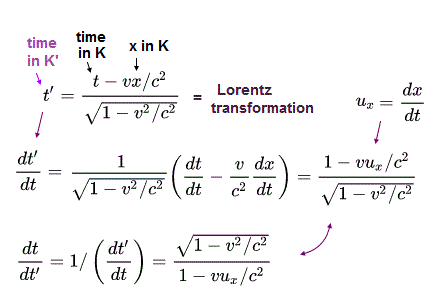
From the equation of Lorentz transformation, we can obtain the time derivative of the other coordinate's time such as dt'/dt and dt/dt' where t is the time measured in K frame, and t' is the time measured in K' frame.
An object's velocity in x direction seen by K is expressed as ux = dx/dt where x is x-coordinate seen by K.
(Eq.2) ux' is an object's velocity in x direction seen by K', and ux is an object's velocity seen by K
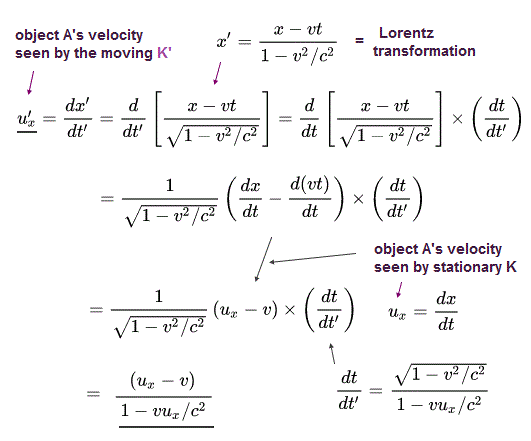
An object A's velocity in x direction seen by the moving K' observer is defined as u'x = dx'/dt' where x' t' are the space and time measured in the moving K' frame.
In the same way, an object A's velocity in x direction seen by the moving K observer is defined as ux = dx/dt where x, t are the space and time measured in the stationary K frame.
Using Eq.1, we can obtain Lorentz transformation of an object's velocity ( u → u'x ) as shown above.
(Eq.3) Lorentz transformation of an object's velocity in y direction between the velocity u'y seen by K' and velocity uy seen by K
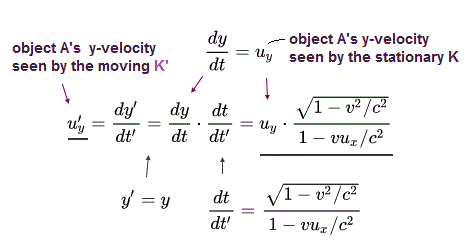
In the same way, using the relation of Eq.1, we can obtain Lorentz tansformation between an object's velocity in y direction seen by K' (= u'y ) and seen by K (= uy ), as shonw above.
K' observer is moving in x direction, so y-coordinates seen by K and K' are the same y = y'.
(Eq.4) An object A's acceleration in x direction seen by K' (= du'x/dt' ) and seen by K (= dux/dt )
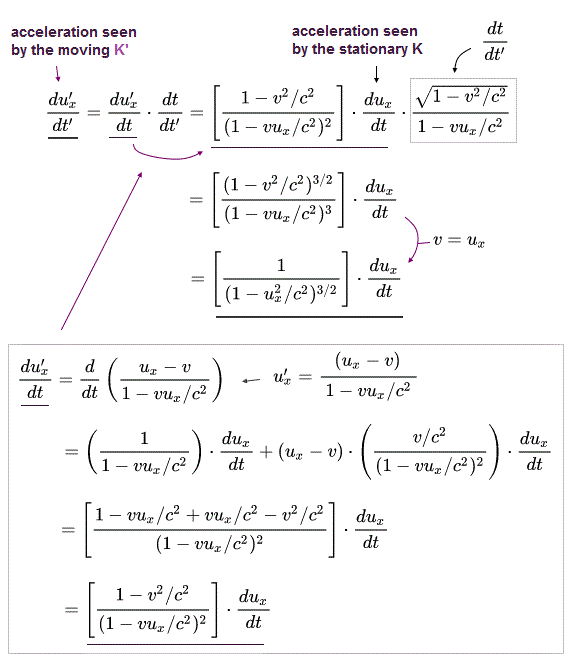
Acceleration is defined as the time derivative of an object A's velocity.
Using Eq.1 and Eq.2, we can obtain the relation (= Lorentz transformaion of acceleration ) between the object A's acceleration in x direction seen by the moving K' observer (= du'x/dt' This K' observer is moving at the same speed v = ux as this object at this point, so u'x = 0 ), and an object's acceleration in x direction seen by the stationary K (= dux/dt ).
(Eq.5) Force (= Fx ) equals the time derivative of an object's momentum p
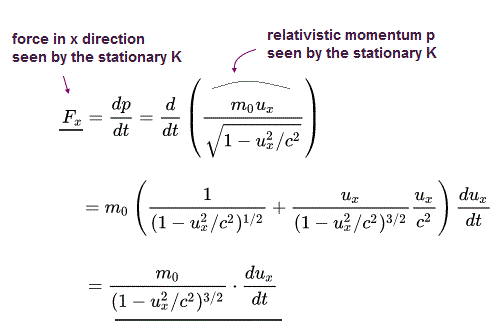
Force in x direction (= Fx ) is defined as the time derivative of an object's (relativistic) momentum p in x direction ( Fx = dpx/dt ).
So we can obtain the upper equation of force (= Fx ) in x direction in K frame or seen by K ( this p.46 )
(Eq.6) Force acting on an object A in x direction is the same seen by K (= Fx ) and K' (= F'x ), Fx = F'x
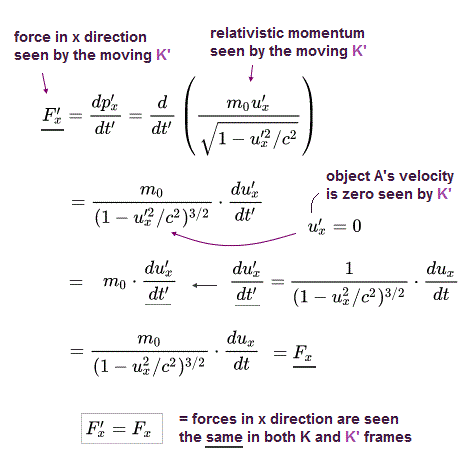
In the same way, the force acting on an object A in x direction seen by the moving K' (= F'x ) becomes like the upper figure.
This object A appears to stop seen by the observer K' moving at the same speed as the object, so the object A's velocity is zero u'x = 0 seen by K'
From Eq.5 and Eq.6, we can know that forces acting on an object in x direction does Not change seen by the stationary K (= Fx ) or seen by the moving K' (= F'x ). Fx = F'x = F|| ( this last, this p.15, this last )
It means the force in the x direction (= parallel to the observer K's moving direction) is unchanged both in K and K' frames under Lorentz transformation.
(Eq.7) Lorentz transformation of acceleration of the object A in y direction seen by K' (= du'y/dt' ) and seen by K (= duy/dt )
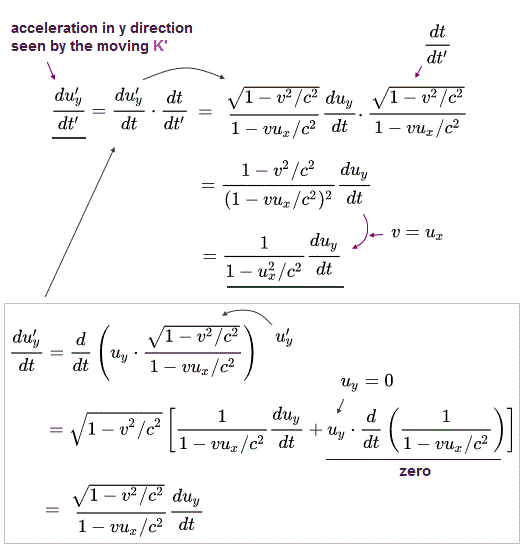
Using Eq.3 and Eq.1, we can obtain Lorentz transformation of the acceleration of an object A as seen by the K' moving at the same speed (= v = ux ) as the object A, and as seen by the stationary K ( this p.22 ).
The object A is moving at a velocity ux in x direction (= so velocity in y direction is zero, uy = 0 ) seen by the stationary K, This object A appears to stop seen by the K' observer moving at the same speed (= temporarily, v = ux ) as the object A.
(Eq.8)
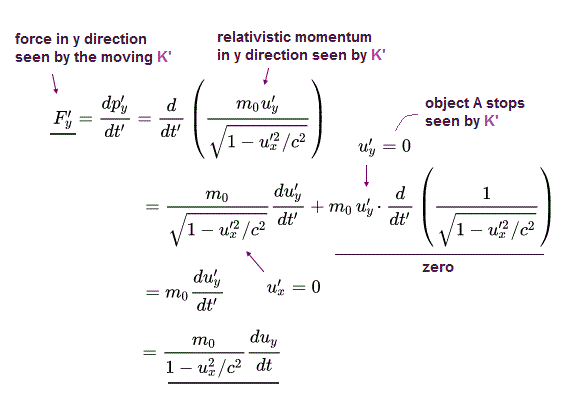
Force is defined as the time derivative of the object's relativistic momentum p.
Using Eq.7, we can obtain the equation above in this situation.
(Eq.9) Force in y direction, which is moving in x direction seen by the stationary K (= Fy ), appears to be smaller than the force in y direction (= F'y ), which stops seen by the K' observer moving at the same speed in x direction as the object A and its force ( Fy < F'y )
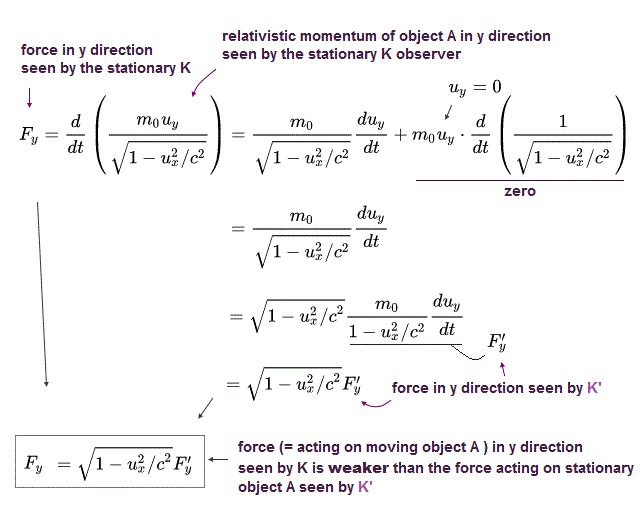
From Eq.8, we can conclude that the moving force in y direction (= Fy ) acting on a moving object A seen by the stationary K appears to be weaker than the force in y direction acting on a stationary object A in y direction (= F'y or F'⊥ ) seen by the K' moving in x direction at the same speed as this object A ( this last, this p.15, this last ).
So the force in y direction (= perpendiculat to Lorentz boost direction of K' observer ) acting on the same object appears to increase or decrease depending on the differently-moving observers, which relativistic force causes serious paradox.

2022/11/22 updated. Feel free to link to this site.